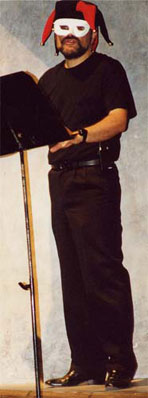| A
WORK ACROSS CENTURIES.
Starting
with the musical work and stage adaptation by Lancino, based on the
« Ship of Fools » by Sebastian Brant, we offer
a theatrical production lasting for about 75 minutes. It consists
of a series of short musical pieces of 1 to 5 minutes, each related
to an aphorism of this huge work and linked between themselves by
a biting and vivid text, astonishingly contemporary. Declaimed by
an actor, this work presented in its poetic and musical context, takes
on a new dimension with this stage version. The imagination of the
audience is all the more stimulated because the form offers a « flavorful »
alternation between the text and the music, joining them sometimes.
One will find an exceptional combination of strong and modern aphorisms
with very picturesque music. Composed by a composer five centuries
after Brant’s writings, the music is often mocking and ironic,
sometimes grave, following the text that it expresses and the wood
engravings of which some are attributed to young Dürer.
This production, where love of music, words, voices, and images mingle
in all their extravagant scintillation and from which emerges an imaginary
world close to that of Jerôme Bosch. The original music inspired
by the text, conceived according to the engravings, is enhanced by
remarkable variety of instrumental and vocal colors.
The
Audience embarks gaily or sometimes seriously on a vivid trip to the
land of vices and passions.
The
show has been premiered in Sebastian Brant’s hometown, Strasbourg,
during the 1996 MUSICA International Festival which commissioned the
work.
It is during the Carnival of 1494 that the “Ship of Fools”
by humanist Sebastian Brant from Strasbourg (Alsace) was published
in Basel. Consisting of 112 independent chapters, the work had an
immediate and striking success and became one of the most widely read
books of the 16th century.
The theme has been used a number of times since, for example the painting
by Bosch “The Ship of Fools” (Le Louvre Museum, Paris),
“In Praise of Folly” by Erasme, certain books from “Pantagruel”
by Rabelais, some of the “Essais” by Montaigne, etc…
The work seems to be inspired by a tradition of Mardi Gras (High and
Low Rhine), or real and astonishing village practices, described in
“The History of Madness” by Michel Foucault. It shows all
the fools of the region embark for the kingdom of folly “Narragonia.”
Each one of the chapters is devoted to describing human follies, vices
or passions. An engraving (woodcut) gives for each one of them a gripping
image of the folly in question. Each plate is accompanied by a short
description or moral or saying (popular or invented by the author).
This text, in its lively versed version by Edwin H. Zeydel, particularly
up-to-date, funny, disturbing, is devoted to depicting human excesses
such as power, gossip, slander, adultery, conceit, rudness, flattery,
etc …
In
a mad rush superbly depicted, the fools throw themselves to the rails
claiming their madness.
|

